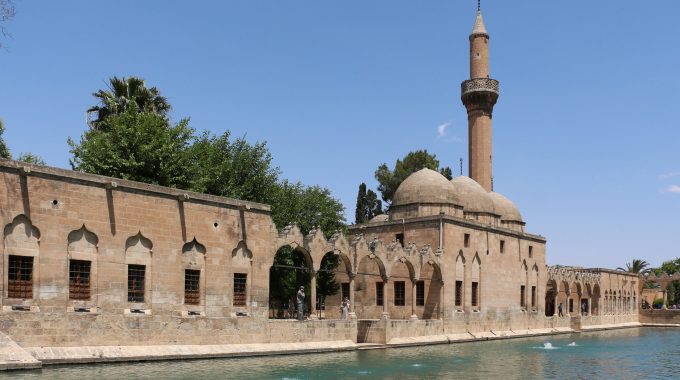
A European Journey #95 – Urfa (Turkey)
Scholars like Vishal Mangalwadi or Tom Holland have demonstrated that the Western legal tradition finds its roots in the Bible. But how could a law that God gave to Moses in a remote land by the Red Sea possibly have such an impact?
After Pentecost, when the first Christians began to spread the Gospel beyond the borders of Israel, they also passed on the Hebrew Scriptures to the people they reached. Thus, when rulers converted to Christianity, they learned the Torah, including the Ten Commandments, which was actually a sort of constitution for the nation of Israel in biblical times. As a result, they discovered where their legal systems were at odds with God’s standards and began to reform them.
In the city of Edessa, today Urfa or Şanlıurfa in Turkey, there is a location that bears witness to how two rulers sought to make the laws of their nations more biblical. At the foot of the castle hill that we visited in a previous stage (stage 92), there is a mosque named Rizvaniye. It is located by a pool called Balıklıgöl, meaning Abraham Pool. This mosque was built during the Ottoman rule in the eighteenth century. According to a legend, Abraham had been thrown into the fire by king Nimrod, but God had turned the fire into a pool to save the Patriarch. Even if this location is presently dedicated to Islam, it was once the site of what was probably the first church building of Edessa: a cathedral built in the second century. And interestingly, Early texts mention that this construction was built according to the model of the temple in Jerusalem, which had been destroyed only a few decades earlier.
So, who were the two rulers connected to the cathedral of Edessa?
The first one is Abgar VIII, also named Abgar Bar Manu. He was king of the small kingdom of Osroene from 177 to 212, and his palace was on the castle hill just behind where we are today. Abgar VIII should not be confused with king Abgar V, the first Christian ruler in Edessa a century earlier (stage 92). In the days of Abgar VIII, Osroene had become a buffer state between the Roman Empire and the kingdom of Armenia. And so, even if Osroene was still ruled by a king, it was regularly subdued either by Armenia or Rome.
When Abgar was king, Osroene was under Roman rule when Christianity was illegal in the Empire. However, during his reign, Abgar was deeply concerned to see his people living ungodly lives, and so, in spite of Rome’s stance, he dared to reform the laws of his land according to biblical standards. For example, since the first commandment said ‘Thou shalt have no other god’, Abgar forbade the practice of self-mutilation in honour to the false goddess Cybele. And anyone who would dare to continue this rite would have his hands cut off. Moreover, archaeological research has revealed that it was under king Abgar VIII that the coins in Edessa had no more signs of Baal who was then a widely worshipped pagan divinity.
Such decisions to reform a kingdom according to biblical standards were a novelty in Abgar’s time. But within a hundred years after his death, both Armenia and Rome had adopted Christianity as their official faith, and very quickly they began to adopt similar legal reforms.
The second ruler related to this cathedral was the sixth-century Byzantine emperor Justinian I, also known as Justinian the Great. In his time, the cathedral, named after St. Thomas, had been destroyed by a flood. Justinian thus rebuilt a new cathedral on this site and he named it St. Sophia, just like the cathedral of Constantinople, which was also built during his reign.
Justinian was not only a builder of cathedrals, for like Abgar VIII, he also brought significant legal reforms to the Byzantine Empire through the famous Codex Justinianus. In his book This Book Changed Everything Vishal Mangalwadi explains that the code was, in fact, greatly inspired by the Bible. Justinian’s body of laws later became the foundation of the Canon Law which was established in mediaeval Roman Catholic Europe. Today, even though modern lawmakers are largely unaware of the biblical foundations of Western law and rarely recognize them, it is still built upon these early legal developments which were grounded in the Bible.
Finally, let me share a few words about the history of this cathedral. Today, we are actually not visiting a cathedral but a mosque. So, the main question is: ‘Whatever happened to the ancient cathedral of Edessa?’
A couple of centuries after the reign of Justinian I, the Muslims began to invade the land. At the time, there were at least seventeen churches in Edessa. Many of them were built in the early Byzantine architectural style. Initially, the new Muslim rulers tolerated the presence of churches and of Christians in the city. However, in the twelfth century, nearly all the churches had disappeared, including the early cathedral built in the second century. The stones of the churches were then reused to build mosques or defensive walls in Edessa, and some of the stones are still visible today.
So, even if the voice of the church is not as strongly heard in Edessa as it once was, as Jesus said, ‘if people keep quiet, the stones themselves will cry out!’
See you next week somewhere else in Europe.
Cédric Placentino
Follow A European Journey here.
Picture: Source: Wikipedia – User: Bernard Gagnon – License: https://creativecommons.org/licenses/by-sa/3.0/legalcode

This Post Has 0 Comments